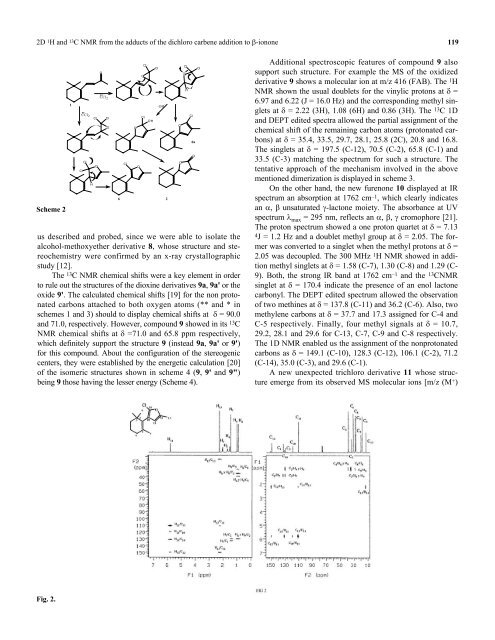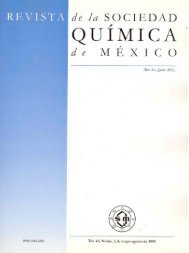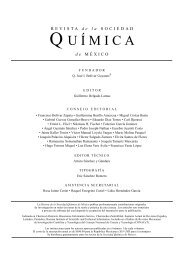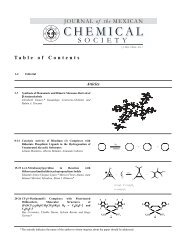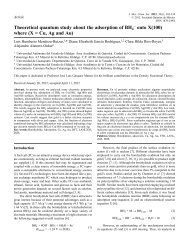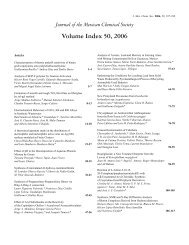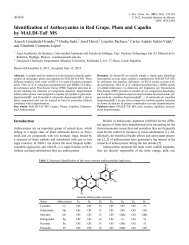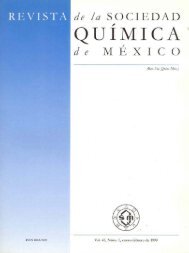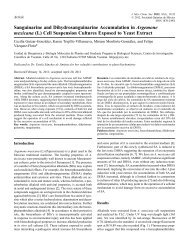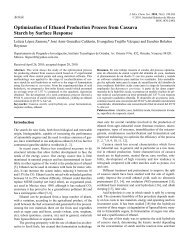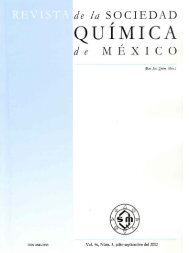SMQ-V047 N-002_ligas_size.pdf - Journal of the Mexican Chemical ...
SMQ-V047 N-002_ligas_size.pdf - Journal of the Mexican Chemical ...
SMQ-V047 N-002_ligas_size.pdf - Journal of the Mexican Chemical ...
Create successful ePaper yourself
Turn your PDF publications into a flip-book with our unique Google optimized e-Paper software.
2D 1 H and 13 C NMR from <strong>the</strong> adducts <strong>of</strong> <strong>the</strong> dichloro carbene addition to β-ionone 119<br />
Scheme 2<br />
1<br />
Cl<br />
CCl 2<br />
Cl<br />
H<br />
Cl<br />
O<br />
O<br />
CCl 2<br />
Cl<br />
O<br />
6<br />
Cl<br />
O<br />
O<br />
us described and probed, since we were able to isolate <strong>the</strong><br />
alcohol-methoxye<strong>the</strong>r derivative 8, whose structure and stereochemistry<br />
were confirmed by an x-ray crystallographic<br />
study [12].<br />
The 13 C NMR chemical shifts were a key element in order<br />
to rule out <strong>the</strong> structures <strong>of</strong> <strong>the</strong> dioxine derivatives 9a, 9a' or <strong>the</strong><br />
oxide 9'. The calculated chemical shifts [19] for <strong>the</strong> non protonated<br />
carbons attached to both oxygen atoms (** and * in<br />
schemes 1 and 3) should to display chemical shifts at δ = 90.0<br />
and 71.0, respectively. However, compound 9 showed in its 13 C<br />
NMR chemical shifts at δ =71.0 and 65.8 ppm respectively,<br />
which definitely support <strong>the</strong> structure 9 (instead 9a, 9a' or 9')<br />
for this compound. About <strong>the</strong> configuration <strong>of</strong> <strong>the</strong> stereogenic<br />
centers, <strong>the</strong>y were established by <strong>the</strong> energetic calculation [20]<br />
<strong>of</strong> <strong>the</strong> isomeric structures shown in scheme 4 (9, 9' and 9")<br />
being 9 those having <strong>the</strong> lesser energy (Scheme 4).<br />
O<br />
Cl<br />
Cl<br />
OH<br />
Cl<br />
-<br />
OH<br />
2<br />
O<br />
O<br />
Cl<br />
O<br />
H<br />
Cl<br />
6a<br />
O<br />
Cl<br />
Additional spectroscopic features <strong>of</strong> compound 9 also<br />
support such structure. For example <strong>the</strong> MS <strong>of</strong> <strong>the</strong> oxidized<br />
derivative 9 shows a molecular ion at m/z 416 (FAB). The 1 H<br />
NMR shown <strong>the</strong> usual doublets for <strong>the</strong> vinylic protons at δ =<br />
6.97 and 6.22 (J = 16.0 Hz) and <strong>the</strong> corresponding methyl singlets<br />
at δ = 2.22 (3H), 1.08 (6H) and 0.86 (3H). The 13 C 1D<br />
and DEPT edited spectra allowed <strong>the</strong> partial assignment <strong>of</strong> <strong>the</strong><br />
chemical shift <strong>of</strong> <strong>the</strong> remaining carbon atoms (protonated carbons)<br />
at δ = 35.4, 33.5, 29.7, 28.1, 25.8 (2C), 20.8 and 16.8.<br />
The singlets at δ = 197.5 (C-12), 70.5 (C-2), 65.8 (C-1) and<br />
33.5 (C-3) matching <strong>the</strong> spectrum for such a structure. The<br />
tentative approach <strong>of</strong> <strong>the</strong> mechanism involved in <strong>the</strong> above<br />
mentioned dimerization is displayed in scheme 3.<br />
On <strong>the</strong> o<strong>the</strong>r hand, <strong>the</strong> new furenone 10 displayed at IR<br />
spectrum an absorption at 1762 cm –1 , which clearly indicates<br />
an α, β unsaturated γ-lactone moiety. The absorbance at UV<br />
spectrum λ max = 295 nm, reflects an α, β, γ cromophore [21].<br />
The proton spectrum showed a one proton quartet at δ = 7.13<br />
4J = 1.2 Hz and a doublet methyl group at δ = 2.05. The former<br />
was converted to a singlet when <strong>the</strong> methyl protons at δ =<br />
2.05 was decoupled. The 300 MHz 1 H NMR showed in addition<br />
methyl singlets at δ = 1.58 (C-7), 1.30 (C-8) and 1.29 (C-<br />
9). Both, <strong>the</strong> strong IR band at 1762 cm –1 and <strong>the</strong> 13 CNMR<br />
singlet at δ = 170.4 indicate <strong>the</strong> presence <strong>of</strong> an enol lactone<br />
carbonyl. The DEPT edited spectrum allowed <strong>the</strong> observation<br />
<strong>of</strong> two methines at δ = 137.8 (C-11) and 36.2 (C-6). Also, two<br />
methylene carbons at δ = 37.7 and 17.3 assigned for C-4 and<br />
C-5 respectively. Finally, four methyl signals at δ = 10.7,<br />
29.2, 28.1 and 29.6 for C-13, C-7, C-9 and C-8 respectively.<br />
The 1D NMR enabled us <strong>the</strong> assignment <strong>of</strong> <strong>the</strong> nonprotonated<br />
carbons as δ = 149.1 (C-10), 128.3 (C-12), 106.1 (C-2), 71.2<br />
(C-14), 35.0 (C-3), and 29.6 (C-1).<br />
A new unexpected trichloro derivative 11 whose structure<br />
emerge from its observed MS molecular ions [m/z (M + )<br />
Fig. 2.


